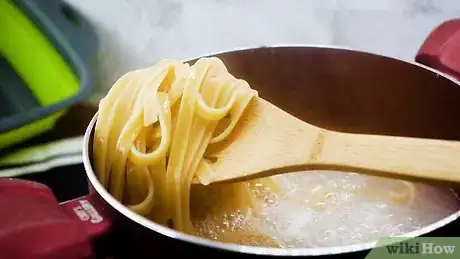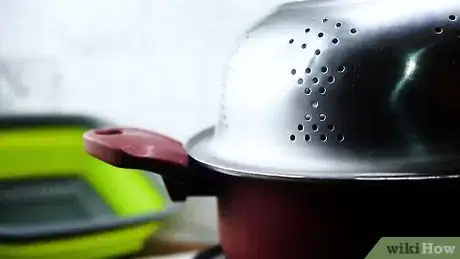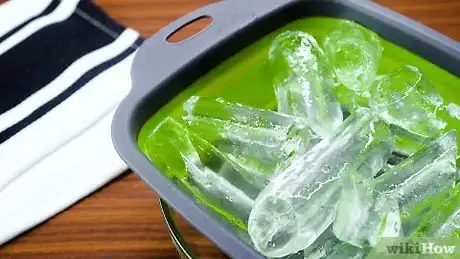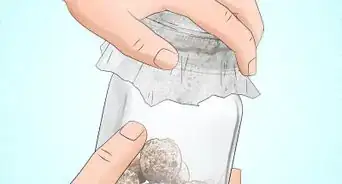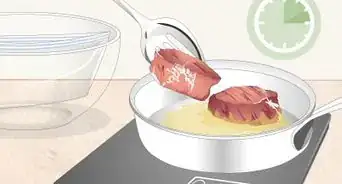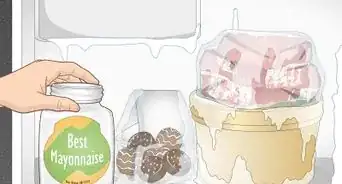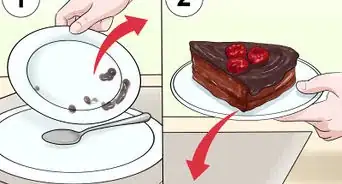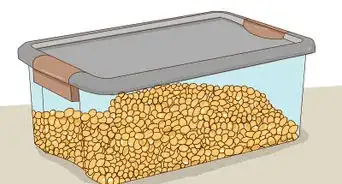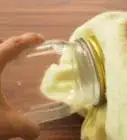This article was co-authored by wikiHow staff writer, Kyle Hall. Kyle Hall works on the content team at wikiHow. He helps manage our team of editors and creates content for a variety of wikiHow projects. Kyle continually looks for new ways to improve the content at wikiHow and make it more helpful and enjoyable for readers. He graduated from Eckerd College in 2015, where he majored in Political Science.
There are 9 references cited in this article, which can be found at the bottom of the page.
This article has been viewed 19,690 times.
Learn more...
A colander is a bowl-shaped kitchen utensil with small holes in it that’s often used to drain pasta. Besides draining pasta, you can use a colander for all kinds of kitchen tasks, like washing produce, sifting flour, and grating cheese. Using one is super easy, and once you get the hang of it, a colander will always be a staple in your kitchen.
Steps
Draining Pasta
-
1Cook your pasta until it’s al dente. Bring a large pot of water to a boil, then add your pasta and let it cook for the recommended time on the packaging. Stir the pasta so it doesn’t stick together. When it’s finished, taste it to make sure it’s the right texture. Al dente pasta should be firm but not crunchy when you bite into it.[1]
-
2Place the colander in your kitchen sink. Put the base of the colander flat on the bottom of the sink. If your sink isn’t empty, take everything out or move it out of the way so the colander is flat and steady.[2]
- Make sure your sink doesn’t have any standing water in it. You don’t want dirty sink water to touch your pasta when you drain it in the colander.
Advertisement -
3Use a ladle to reserve some of the pasta water for your sauce. Pasta water is full of salt and starches left over from the cooking process. When you add pasta water to your pasta and sauce, it makes the sauce smoother and helps it stick to the noodles. Instead of dumping all of the pasta water down the drain, reserve some for your dish. Save about 1 cup (240 mL) of pasta water before you dump the rest out.[3]
- Set the pasta water aside in a bowl or glass until you’re ready to use it.
-
4Pour the pasta and remaining pasta water into the colander. Carry the pot of pasta over to your kitchen sink, being careful not to splash yourself with any of the hot water. Slowly pour the pasta and pasta water into the colander. The water will drain out of the holes in the colander, leaving you with perfectly cooked pasta that’s ready to be mixed with some sauce.[4]
- Don’t rinse the pasta after you drain it. Rinsing it removes some of the starches, which are necessary for helping the sauce stick to the noodles.[5]
-
5Transfer the drained pasta back to the pot and add your sauce. Carefully pour the pasta out of the colander and into the pot. Then, add your sauce along with the pasta water you set aside. Stir everything together and enjoy!
Finding Other Uses for Your Colander
-
1Steam vegetables with a metal colander if you don’t have a steamer. You’ll need a pot that’s wide enough to hold the rim of the colander and deep enough that the colander doesn’t sit on the bottom of it. Fill the pot with 1 inch (2.5 cm) of water and bring it to a boil.[6] Place the colander on top with the vegetables inside, and cover the pot with a lid to trap the steam inside while everything cooks.[7]
-
2Wash fruits and vegetables in your colander. When you’re ready to use fresh produce, place it in a plastic or metal colander, hold it under your kitchen sink faucet, and run some cold water. Give the colander a few shakes to make sure all of the produce gets rinsed off. Then, pat the produce dry with a paper towel.
- Always wash your fresh produce before eating it to prevent food-borne illness.[8]
-
3Sift dry ingredients with a colander if you don’t have a sifter. Add any dry ingredients you’re using in your recipe, like flour and baking soda, to a plastic or metal colander and shake it back and forth over a bowl. Once the dry ingredients are sifted in the bowl, add them to your recipe.[9]
- Sifting dry ingredients helps remove lumps so they don't end up weighing down your batter.
-
4Use your colander to prevent grease splatters while you cook. If you’re cooking something on your stovetop and you don’t want grease to get everywhere, turn a metal colander upside down and place it over the pan you’re cooking with. The colander will catch all of the grease splatters, and you can just wipe it down with soapy water when you’re finished.
- Be careful touching the colander after you're done catching grease with it in case it’s hot.
-
5Make extra-creamy mashed potatoes with a colander. First, cook your potatoes and place them in a plastic or metal colander. Then, use a potato masher or stiff spatula to press the potatoes through the holes in the colander. Catch the mashed potatoes in a bowl underneath.[10]
- Forcing the cooked potatoes through the small holes in a colander will make them extra smooth and creamy.
- You can also use a colander to mash other things, like avocados and pumpkin.
-
6Use the side of your colander to grate cheese. If you don’t have a cheese grater on hand, you can use a metal colander instead. Just take a block of semi-firm cheese, like cheddar or gruyere, and drag it along the inside of the colander. Collect the grated cheese in the bottom of the colander, then add it to your recipe when you’re ready to use it.[11]
-
7Turn a colander into an ice bucket that easily drains. If you need an ice bucket for champagne, wine, or other beverages, use a plastic or metal colander instead. Place the colander on top of a large bowl, then fill it with ice and add your drinks. As the ice melts, it will drain into the bowl underneath. Instead of having your drinks sitting in a bucket of melted water, you can just add more ice whenever the old ice melts and drains away.[12]
- Remember to empty out the bowl underneath the colander whenever it gets full so it doesn’t overflow.
Community Q&A
-
QuestionWhat can I use if I don't have a colander?
 Otterly BadgerificTop AnswererIf you don't have a colander, you could use a steamer pan (the pot with the holes); a sieve; the lid of a pan held against the pan as you pour; or just use tongs to pick the food directly out of the hot water without touching the water. Colanders are not expensive, so do yourself a favor and pick one up next time you shop at the supermarket.
Otterly BadgerificTop AnswererIf you don't have a colander, you could use a steamer pan (the pot with the holes); a sieve; the lid of a pan held against the pan as you pour; or just use tongs to pick the food directly out of the hot water without touching the water. Colanders are not expensive, so do yourself a favor and pick one up next time you shop at the supermarket.
Warnings
- Never use a colander in a clogged sink or a sink that has standing water. When you go to drain your pasta, the backed-up water will ruin your meal.⧼thumbs_response⧽
References
- ↑ https://www.realsimple.com/food-recipes/cooking-tips-techniques/cooking/cook-pasta
- ↑ https://www.thekitchn.com/survey-drain-cl-157998
- ↑ https://www.seriouseats.com/2014/05/does-pasta-water-really-make-difference.html
- ↑ https://www.thekitchn.com/survey-drain-cl-157998
- ↑ https://www.smithsonianmag.com/arts-culture/youre-doing-it-wrong-the-guide-to-making-perfect-pasta-946855/
- ↑ https://www.thekitchn.com/5-ways-to-steam-vegetables-without-a-basket-231385
- ↑ https://www.bu.edu/scnc/2013/05/28/cooking-basics-how-to-steam-vegetables/
- ↑ https://www.washingtonpost.com/news/voraciously/wp/2019/05/31/yes-you-need-to-wash-your-produce-heres-how/
- ↑ https://www.foodandwine.com/blogs/7-uncommon-ways-use-your-colander
